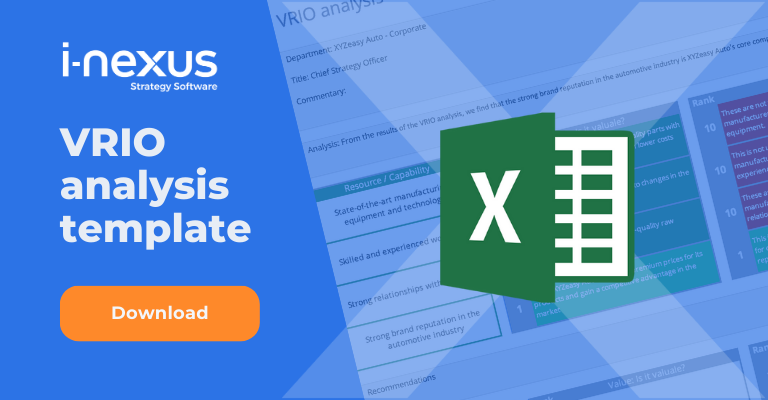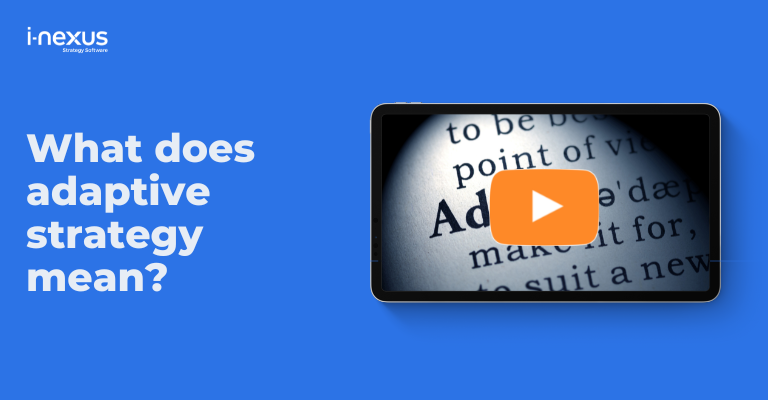Discover all you need to know about the VRIO framework with our go-to guide covering the value of VRIO analyses, how to create your own, examples, templates, and much more.
The VRIO framework analyzes your organization's internal resources and capabilities to determine the potential for sustained competitive advantage.
From this analysis, you can create strategies to drive growth out of this competitive advantage while offering a means to create a strategy to address weaknesses.
This blog post looks at everything you need to know about the VRIO framework. Within, you'll learn about the creation of the VRIO analysis, how to conduct your own, and the value, examples, and answers to your frequently asked questions.
Read on for our guide to VRIO.
Jump to the section you want
- What is a VRIO?
- What are the four elements of a VRIO?
- Who created the VRIO framework?
- How has VRIO evolved?
- VRIO v VRIN
- What are the benefits of VRIO?
- What are the challenges of VRIO?
- How can VRIO help with strategy creation?
- When should you use a VRIO framework?
- Who would be responsible for creating a VRIO analysis?
- How can you create a VRIO analysis?
- Automotive manufacturer example of a VRIO
- What are alternatives to a VRIO analysis?
- VRIO template
What is a VRIO analysis?
The VRIO framework analyzes a firm's internal resources and capabilities to determine if it can provide a sustained competitive advantage.
The acronym VRIO stands for Value, Rarity, Inimitability, and Organization.
The framework was first developed by Jay Barney in his 1991 article "Firm Resources and Sustained Competitive Advantage" and later expanded upon in his book "Resource-Based Theory: Creating and Sustaining Competitive Advantage."
What are the four elements of VRIO?
The VRIO framework consists of four key questions that a firm should ask when evaluating its resources and capabilities:
Value
Is the resource or capability valuable to the firm and its customers?
Rarity
Is the resource or capability rare among the firm's competitors?
Inimitability
Is the resource or capability complex for competitors to imitate or acquire?
Organization
Is the firm organized to exploit the resource or capability?
If a firm's resources and capabilities meet all four criteria, they are considered a source of sustained competitive advantage.
Resources and capabilities that do not meet all four criteria may still be valuable but may not provide a sustained competitive advantage.
The VRIO framework is similar to the Resource-Based View (RBV), which also focuses on a firm's internal resources and capabilities and how they can provide a sustained competitive advantage.
The main difference between the two frameworks is that the VRIO focuses on individual resources and capabilities, while the RBV focuses on the firm as a whole.
The value question
The value part of a VRIO analysis looks at the potential of an organization's resources to generate value for its business.
By examining the potential sources of value, businesses can identify which resources are more likely to bring in greater returns and have a more significant impact on the success of their company.
The benefits of looking at value
There are several reasons why examining the value aspect is essential in a VRIO analysis:
-
It helps to identify growth opportunities
If a firm's resources and capabilities are valuable to customers, it is more likely that the firm will be able to grow by selling more products or services. -
It helps to identify areas for cost reduction
If a firm's resources and capabilities are not valuable to customers, the firm may want to reduce costs by divesting or outsourcing those resources and capabilities. -
It helps to identify areas for innovation
If a firm's resources and capabilities are valuable to customers, the firm may want to invest in developing new resources and capabilities that will be even more valuable to customers. -
It helps to identify the role of customer preferences
Understanding the customers' value is essential in creating a successful strategy, as it enables the firm to develop products or services that align with customer preferences. -
It helps to identify the role of price
The value aspect of VRIO framework assesses the role of price in a firm's resources and capabilities and whether they are valuable to customers.
The rarity question
The rarity part of VRIO examines whether a firm's resources and capabilities are rare, meaning other firms do not widely possess them. This can make it difficult for competitors to imitate or replicate the resource or capability.
Those companies with resources and capabilities that are rare in the marketplace tend to have a competitive advantage over companies with more widely available resources and capabilities.
The benefits of looking at rarity
There are two clear benefits to examining the rarity aspect in a VRIO analysis:
-
It helps to identify the role of economies of scale
Rarity aspect of VRIO framework assesses the role of economies of scale in a firm's resources and capabilities and whether they are rare among competitors, as the possession of economies of scale can be an advantage. -
It helps to identify the role of first-mover advantage
First-mover advantage can make a resource or capability rare among competitors, as the first firm to develop or acquire a resource or capability has a head start over competitors.
The inimitability question
The inimitability test in VRIO looks at whether a company's resources or capabilities are complex for competitors to imitate.
This can be based on factors such as patents, proprietary technology, geographical barriers, and contractual agreements.
The benefits of looking at inimitability
There are several reasons why examining the inimitability aspect is essential in a VRIO analysis.
-
It helps to identify sustainable competitive advantages
If a firm's resources and capabilities are difficult to imitate or acquire, it will more likely provide a sustained competitive advantage. -
It helps to identify potential vulnerabilities
If a firm's resources and capabilities are easy to imitate or acquire, it is more likely not to provide a sustained competitive advantage, and the firm will be vulnerable to competition. -
It helps to identify areas for investment
If a firm's resources and capabilities are easily imitated or acquired, the firm may want to invest in developing new resources and capabilities that are more difficult to replicate or acquire. -
It helps to identify the role of intellectual property and proprietary technology
The inimitability aspect of the VRIO framework assesses the role of intellectual property (patents, trademarks, copyrights) or proprietary technology in protecting a firm's resources and capabilities from imitation or acquisition. -
It helps to identify the role of network effects
Network effects can make a resource or capability more difficult to imitate or acquire, as they increase the value of the resource or capability as more people use it.
The organization question
The organization element of a VRIO looks at whether the firm is structured and equipped to exploit the valuable, rare, and inimitable resources and capabilities it possesses.
Specifically, it examines whether the firm has the systems, processes, and culture to effectively utilize and leverage its resources and capabilities to generate a sustained competitive advantage.
The benefits of looking at your organization
By looking at the organization aspect, it brings up several benefits:
-
It ensures that the firm's resources and capabilities are used to their fullest potential
A firm may have valuable and rare resources, but if it is not organized to use them effectively, it will not be able to create a sustained competitive advantage. -
It identifies areas for improvement
If a firm's resources and capabilities are not being exploited to their fullest potential, a VRIO analysis can identify areas where the organization needs to be improved to take advantage of its resources and capabilities. -
It highlights the importance of culture and alignment
A VRIO analysis looks at the firm's culture and how it aligns with its resources and capabilities.A strong culture that aligns with the firm's resources and capabilities can help to ensure that the firm's resources and capabilities are being used to their fullest potential.
-
It underlines the role of governance and management in leveraging resources
The organization aspect of a VRIO analysis looks at the governance and management systems in place to ensure that the resources are being utilized effectively and efficiently.
Who created the VRIO framework?
Jay B. Barney developed the VRIO framework in 1991 in his article “Firm Resources and Sustained Competitive Advantage.”
The article was published in the Journal of Management and introduced the VRIO framework to analyze a firm's internal resources and capabilities to determine the potential for sustained competitive advantage.
In the article, Barney argues that a resource or capability that is valuable, rare, inimitable, and well-organized can be a source of sustained competitive advantage for a firm.
How has VRIO evolved?
VRIO has undergone some evolution over time.
Initially, the framework was primarily used to analyze a firm's internal resources and capabilities to determine its potential for sustained competitive advantage. However, researchers and practitioners have expanded upon the original framework and adapted it to various contexts.
Dynamic capabilities and VRIO
One of the key developments in the VRIO framework is the incorporation of the concept of dynamic capabilities.
This refers to the ability of a firm to continuously adapt and reconfigure its internal resources and capabilities in response to changes in its external environment.
This is important as it highlights that resources and capabilities that were once rare and inimitable can become common over time and may not be able to sustain a competitive advantage.
Internal v external VRIO
Another development is the incorporation of the concept of the external environment.
The original VRIO framework focused on analyzing internal resources and capabilities. Still, many researchers have expanded the framework to include external factors such as industry conditions, the competitive landscape, and the regulatory environment.
This is important as these external factors can impact a firm's ability to sustain its competitive advantage.
VRIO v VRIN
Additionally, some researchers have proposed variations of the VRIO framework, such as VRINE and VRIN.
These frameworks have different acronym meanings but are based on VRIO, which emphasizes various aspects of the resources and capabilities.
VRINE framework focuses on value, rarity, inimitability, non-substitutability, and exploitation, while VRIN focuses on value, rarity, inimitability, and nonsubstitutability.
While the core concepts of the VRIO framework have remained unchanged, the framework has evolved to incorporate new insights and perspectives.
The incorporation of dynamic capabilities and external environment, and the emergence of different framework variations, have expanded the framework's applicability and provided practitioners and researchers with new ways to analyze a firm's resources and capabilities.
What are the benefits of doing a VRIO analysis?
In summary, a VRIO analysis offers many benefits to those who complete one:
-
It helps to identify a firm's unique resources and capabilities
A VRIO analysis examines whether a firm's resources and capabilities are valuable, rare, inimitable, and well-organized.This helps to identify the resources and capabilities that give a firm a competitive advantage.
-
It helps to identify areas for growth
A VRIO analysis can help identify opportunities for growth by identifying valuable resources and capabilities for customers. -
It helps to identify areas for cost reduction
A VRIO analysis can help to identify areas where a firm should reduce costs by divesting or outsourcing resources and capabilities that are not valuable to customers. -
It helps to identify areas for innovation
A VRIO analysis can help to identify areas where a firm should invest in developing new resources and capabilities that will be even more valuable to customers. -
It helps to identify the role of customer preferences
Understanding what the customers value is important in creating a successful strategy, as it enables the firm to develop products or services that align with customer preferences. -
It helps to identify the role of price
The value aspect of VRIO framework assesses the role of price in a firm's resources and capabilities and whether they are valuable to customers. -
Assessing internal resources and capabilities
VRIO analysis allows the firm to evaluate its internal resources and capabilities and compare them with its competitors, which helps to identify its strengths and weaknesses. -
Create strategies
The findings of a VRIO analysis can be used to develop effective strategies which are formed in a way that aligns with the firm's resources and capabilities. -
Improving decision-making
VRIO analysis provides a structured way to evaluate a firm's resources and capabilities, which can help to improve decision-making.
What are the challenges of VRIO?
There are several challenges associated with conducting a VRIO analysis:
-
Difficulty in determining rarity and inimitability
Determining whether a resource or capability is truly rare or inimitable can be difficult, as it may not be immediately apparent and require extensive research. -
Difficulty in determining value
Determining the value of a resource or capability to customers can be difficult, as customer preferences and needs may change over time. -
Difficulty in determining organization
Determining the level of organization within a firm can be difficult, as it may not be immediately apparent and may require extensive research. -
Limited scope
The VRIO framework is focused on analyzing a firm's internal resources and capabilities, and it does not consider external factors that may also be important for sustained competitive advantage.While the VRIO analysis is a powerful tool for identifying internal resources and capabilities that can be leveraged for sustained competitive advantage, it should be used in conjunction with other analytical frameworks such as PESTEL, SWOT, or resource-based view, which take into account external factors as well.
-
Time-consuming
Conducting a VRIO analysis can be a time-consuming process, especially if the firm has a large number of resources and capabilities.This can be a disadvantage for firms looking for a quick and straightforward way to analyze their internal resources and capabilities.
-
Complex
The VRIO framework can be complex to understand and apply, and it may require specialized knowledge and skills to conduct a thorough analysis.This can be a disadvantage for firms that do not have the resources to devote to a detailed analysis.
-
Limited to specific industries
The VRIO framework is most relevant for firms in industries where resources and capabilities can be leveraged for sustained competitive advantage.
For example, in the service industry, a VRIO analysis may not be as useful as it is in the manufacturing industry. -
Limited to specific stages of the firm's life
VRIO analysis is most relevant for firms that are looking to gain or maintain a competitive advantage; it may not be as useful for firms that are in the early stages of their life cycle or for firms that are in decline. -
Limited data availability
VRIO analysis requires access to a lot of data; if data is unavailable, it can be challenging to conduct accurate and comprehensive research.
How can a VRIO analysis help you with creating a strategy?
A VRIO analysis can help a firm build a strategy by identifying the resources and capabilities that can be leveraged for sustained competitive advantage.
A VRIO analysis can provide insight into which resources and capabilities are most likely to provide a sustainable source of competitive advantage by assessing a firm's internal resources and capabilities in terms of value, rarity, inimitability, and organization.
Once a firm has identified its unique resources and capabilities, it can develop a strategy that leverages these assets.
With these findings, you can:
-
Identify core competencies
A VRIO analysis can help a firm identify its key resources and capabilities that are valuable, rare, inimitable, and well-organized.
These resources and capabilities can be considered the firm's core competencies and can be leveraged to create sustained competitive advantage. -
Develop a competitive advantage
A VRIO analysis can help a firm identify resources and capabilities that can be leveraged to create sustained competitive advantage.
Once these resources and capabilities are identified, the firm can develop strategies to exploit them and create a unique value proposition for its customers. -
Allocate resources
A VRIO analysis can help a firm identify which resources and capabilities are most critical to its success.The firm can then allocate resources to these critical areas to exploit them and create a sustained competitive advantage.
-
Identify areas for improvement
A VRIO analysis can also help a firm identify areas where its resources and capabilities are not valuable, rare, inimitable, or well-organized.The firm can then develop strategies to improve these areas and increase its potential for sustained competitive advantage.
-
Identify opportunities for collaboration
A VRIO analysis can help a firm identify resources and capabilities that are valuable but not rare or inimitable.These resources and capabilities may be better leveraged through collaboration with other firms.
-
Identify opportunities for divestment
A VRIO analysis can also help a firm identify resources and capabilities that are not valuable, rare, inimitable, or well-organized.These resources and capabilities may be better divested to focus on more critical areas.
Some further examples include:
Example: Brand strength
For example, if a firm has a strong brand reputation that is valuable, rare, and inimitable, it can develop a branding strategy that emphasizes its brand identity and leverages the brand reputation to differentiate itself from its competitors.
Example: Weak systems and processes
A VRIO analysis can also help a firm identify areas to improve to maintain its competitive advantage.
For example, if a firm has a resource or capability that is valuable and rare but it is not well-organized, it may need to invest in better systems and processes to effectively exploit the resource or capability.
Example: Mergers and acquisitions
Furthermore, a VRIO analysis can help a firm identify resources and capabilities that it can develop or acquire to improve its competitive position.
For example, a firm with no unique resources or capabilities in a particular area may decide to invest in research and development to develop new resources or capabilities in that area to improve its competitive position.
When should you use a VRIO framework?
A VRIO analysis is typically used when a firm wants to understand its internal resources and capabilities and how they can be leveraged to achieve sustained competitive advantage. Therefore, a VRIO analysis is helpful in several situations, including:
-
Strategy creation
Before developing a new strategy or making significant decisions, a firm can conduct a VRIO analysis to understand its internal resources and capabilities and how they can be leveraged to achieve competitive advantage. -
Competitive analysis
A VRIO analysis can evaluate a firm's competitive position and identify areas where it may be disadvantaged compared to its competitors. -
Mergers and Acquisitions
A VRIO analysis can be used to evaluate the resources and capabilities of a potential acquisition target to determine if they would provide a sustainable source of competitive advantage. -
Resource allocation
A VRIO analysis can be used to evaluate the resources and capabilities of a firm to determine which ones should be invested in, divested, or phased out. -
Identifying new growth opportunities
By conducting a VRIO analysis, a firm can identify new growth opportunities by identifying resources or capabilities that are valuable, rare, and inimitable and can be leveraged to create new products or services that are in high demand by customers.
Who would be responsible for creating a VRIO analysis?
A VRIO analysis is typically created by a firm's strategic planning or management team - this could be the strategy realization office.
This team analyzes the firm's internal resources and capabilities and determines how they can be leveraged to achieve sustained competitive advantage.
The team typically includes:
-
Senior management
The CEO, COO, CSO, CIO, and other senior executives often lead the strategic planning process and make significant decisions about the firm's direction and resources. -
Strategic planners
These individuals work closely with senior management to develop and implement the firm's strategy. They are responsible for conducting the VRIO analysis and providing recommendations based on the results. -
Functional managers
These are the managers of the different functional areas of the firm, such as finance, marketing, and operations. They provide input into the VRIO analysis by providing information about the resources and capabilities of their respective areas. -
External consultants
The firm may also hire external consultants to conduct a VRIO analysis. These consultants bring expertise and a fresh perspective to the analysis and can provide valuable insights into the firm's competitive position.
It is important to note that the VRIO analysis should be done with the participation of all stakeholders, as it can help better understand the firm's resources and capabilities and how they can be leveraged for sustained competitive advantage.
How can you create a VRIO analysis?
Here is an eight-step process for creating your VRIO analysis:
-
Identify and list your resources and capabilities
The first step in conducting VRIO research is identifying your resources and capabilities.
This includes tangible and intangible assets such as technology, brand, patents, and human resources. -
Determine the value of the resources and capabilities
The next step is to determine the value of those resources and capabilities.
This includes assessing the value of the resources and capabilities to your customers and determining how they contribute to your competitive advantage. -
Determine rarity and inimitability
Determine whether the resources and capabilities are rare and inimitable.
This means that the resources and capabilities are not easily replicated or imitated by your competitors. -
Determine organization
Determine whether the resources and capabilities are well-organized and integrated within your organization.
This means that the resources and capabilities are used effectively and efficiently to achieve your goals. -
Evaluate results
Evaluate the results of the VRIO analysis by determining which resources and capabilities are valuable, rare, inimitable, and well-organized.
These resources and capabilities are considered your core competencies and should be the focus of your strategies. -
Prioritize
Prioritize the VRIO resources and capabilities based on their importance to your organization and its competitive advantage.
Use a color-coded approach and invite some feedback from senior leaders to create a multi-person view. -
Create a strategy
Use the findings of the VRIO analysis to develop a strategy that leverages the firm's core competencies and addresses any deficiencies identified in the analysis. -
Review and update
Periodically review and update the VRIO analysis to ensure that your resources and capabilities are aligned with its strategic goals and the competitive environment is changing.However, be wary that this should be monthly and quarterly to ensure you're keeping relevant and timely with identifying changes and updating your strategies.
The review and update of your VRIO are encouraged through a continuous approach to strategy. To learn more about that approach, watch our webinar about an adaptive approach to strategy:
What are some examples of a VRIO?
When conducting your VRIO, examples often go a long way. Here is an example of a manufacturer, XYZeasy Auto, and their results.
XYZeasy Auto
A mid-sized automotive parts manufacturer, XYZeasy Auto, has decided to conduct a VRIO analysis to identify its core competencies and develop a strategy for growth.
A team of managers and consultants conducts the analysis.
- Identify the firm's resources and capabilities
The team begins by identifying XYZeasy Auto's resources and capabilities. These include:
- State-of-the-art manufacturing equipment and technology
- Skilled and experienced workforce
- Strong relationships with suppliers
- Strong brand reputation in the automotive industry
- Determine the value of the resources and capabilities
The team then evaluates the value of these resources and capabilities to the firm. They determine that:
- The manufacturing equipment and technology allow XYZeasy Auto to produce high-quality parts with high precision and efficiency, resulting in lower costs and higher profits.
- The skilled and experienced workforce allows XYZeasy Auto to quickly adapt to changes in the market and develop new products.
- The strong relationships with suppliers allow XYZeasy Auto to access high-quality raw materials at competitive prices.
- The strong brand reputation in the automotive industry allows XYZeasy Auto to charge premium prices for its products and gain a competitive advantage in the market.
- Determine rarity
The team then determines whether the resources and capabilities are rare. They find that:
- The manufacturing equipment and technology are not unique to XYZeasy Auto, as other manufacturers in the industry also have similar equipment.
- The skilled and experienced workforce is not unique to XYZeasy Auto, as other manufacturers in the industry also have skilled and experienced workers.
- Strong relationships with suppliers are not unique to XYZeasy Auto, as other manufacturers in the industry also have strong relationships with suppliers.
- A strong brand reputation in the automotive industry is rare, as it is difficult for other manufacturers to establish a strong brand reputation.
- Determine inimitability
The team then determines whether the resources and capabilities are inimitable. They find that:
- The manufacturing equipment and technology are not inimitable, as other manufacturers in the industry can also acquire similar equipment.
- The skilled and experienced workforce is not inimitable, as other manufacturers in the industry can also hire skilled and experienced workers.
- Strong relationships with suppliers are not inimitable, as other manufacturers in the industry can also establish relationships with suppliers.
- A strong brand reputation in the automotive industry is inimitable, as it takes significant time and resources to establish a strong brand reputation.
- Determine organization
The team then determines whether the resources and capabilities are well-organized and integrated within the firm. They find that:
- The manufacturing equipment and technology are well-organized and integrated within the firm, as it is used effectively and efficiently to produce high-quality parts.
- The skilled and experienced workforce is well-organized and integrated within the firm, as it is used effectively and efficiently to adapt to changes in the market and develop new products.
- The strong relationships with suppliers are well-organized and integrated within the firm, as they are used effectively and efficiently to access high-quality raw materials at competitive prices.
- The strong brand reputation in the automotive industry is well-organized and integrated within the firm. It is used effectively and efficiently to charge premium prices for its products and gain a competitive advantage in the market.
-
Evaluate results
The team evaluates the results of the VRIO analysis and finds that the strong brand reputation in the automotive industry is the firm's core competency, as it is valuable, rare, inimitable, and well-organized. -
Prioritize
Prioritize the VRIO resources and capabilities based on their importance to the firm and its competitive advantage. -
Develop a strategy
Use the findings of the VRIO analysis to develop a strategy that leverages the firm's core competencies and addresses any deficiencies identified in the analysis. -
Review and update
Periodically review and update the VRIO analysis to ensure that the firm's resources and capabilities are aligned with its strategic goals, and that the competitive environment is changing.
Several frameworks and tools can be used as an alternative to a VRIO analysis to assess a firm's internal resources and capabilities and determine its potential for sustained competitive advantage. Some alternatives include:
-
Resource-Based View (RBV)
The RBV framework focuses on a firm's internal resources and capabilities, similar to the VRIO framework. Still, it also looks at the external environment to determine how resources and capabilities can be leveraged to achieve sustained competitive advantage. -
Value Chain Analysis
This framework focuses on analyzing the different activities of a firm and how they contribute to creating value for the customer. It can identify areas where a firm has a competitive advantage or disadvantage. -
Five Forces Framework
Michael Porter developed this framework to analyze a firm's competitive environment and identify the five main forces determining the intensity of an industry's competition. -
PESTLE Analysis
This framework analyzes a firm's external environment and identifies factors that may positively or negatively impact its performance. -
SWOT Analysis
As mentioned, the SWOT analysis is a framework used to analyze a firm's internal and external environment and identify its internal strengths and weaknesses and external opportunities and threats.
It is important to note that each of these frameworks has its strengths and weaknesses and that the best approach is to use a combination of different frameworks, such as a VRIO and SWOT analysis, to provide a more comprehensive understanding of a firm's competitive position.
Complete your VRIO analysis with i-nexus
Creating your VRIO analysis has never been easier with this Excel template, available to download by clicking the link below.
This template provides a clear and easy-to-use format for identifying, evaluating, and analyzing your organization's resources and capabilities.
It guides you through determining the value, rarity, inimitability, and organization of your resources, making it simple to identify your core competencies and develop a strategy that leverages them.
Click below to download the template and easily create your VRIO analysis.
Learn more about strategy execution
Take the next steps in your journey by exploring our strategy execution resource hub.
About the author
James Milsom is Head of Marketing at i-nexus.
As Head of Marketing, his drive is to raise awareness and understanding of the challenges facing enterprises in delivering strategic objectives and transformation amidst changing markets and the obstacles traditional tools and methods present leaders.
If you’d like to talk more about strategy, reach out to James on james.milsom@i-nexus.com or connect with him on LinkedIn for the latest insights.





